brakes CADILLAC SEVILLE 1994 4.G Owners Manual
[x] Cancel search | Manufacturer: CADILLAC, Model Year: 1994, Model line: SEVILLE, Model: CADILLAC SEVILLE 1994 4.GPages: 399, PDF Size: 21.33 MB
Page 9 of 399
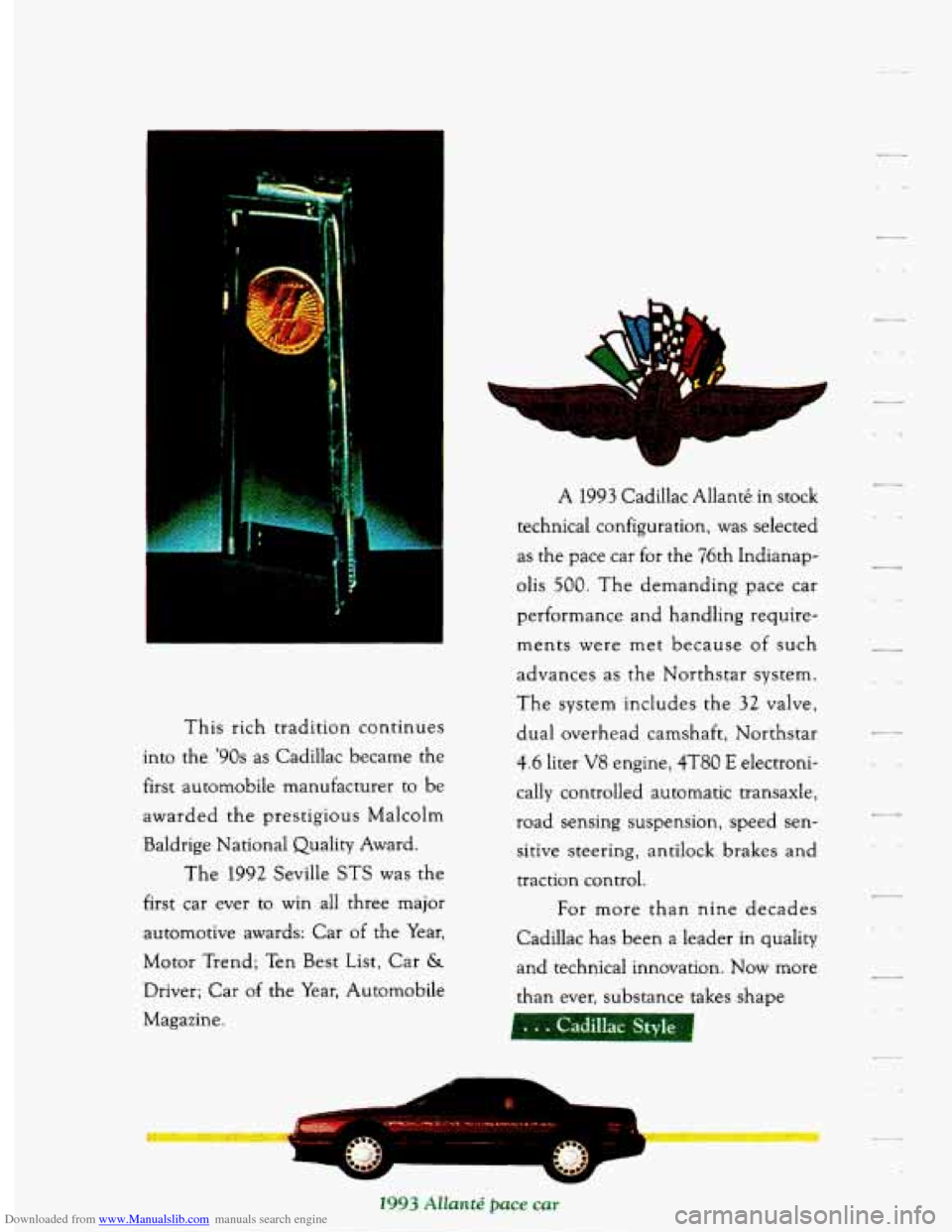
Downloaded from www.Manualslib.com manuals search engine This rich tradition continues
into the
'90s as Cadillac became the
first automobile manufacturer to be
awarded the prestigious Malcolm
Baldrige National Quality Award.
The 1992 Seville
STS was the
first car ever to win all three major
automotive awards: Car of the Year,
Motor Trend; Ten Best List, Car
&
Driver; Car of the Year, Automobile
Magazine.
A 1993 Cadillac Allantk in stock
technical configuration, was selected
as the pace car for the
76th Indianap-
olis
500. The demanding pace car
performance and handling require- ments were met because of such
advances as the Northstar system.
The system includes
the 32 valve,
dual overhead camshaft, Northstar
4.6 liter V8 engine, 4T80 E electroni-
cally controlled automatic transaxle,
road sensing suspension, speed sen-
sitive steering, antilock brakes and
traction control. For more than nine decades
Cadillac has been a leader in quality
and technical innovation.
Now more
than ever, substance takes shape
-
L .&
Page 102 of 399
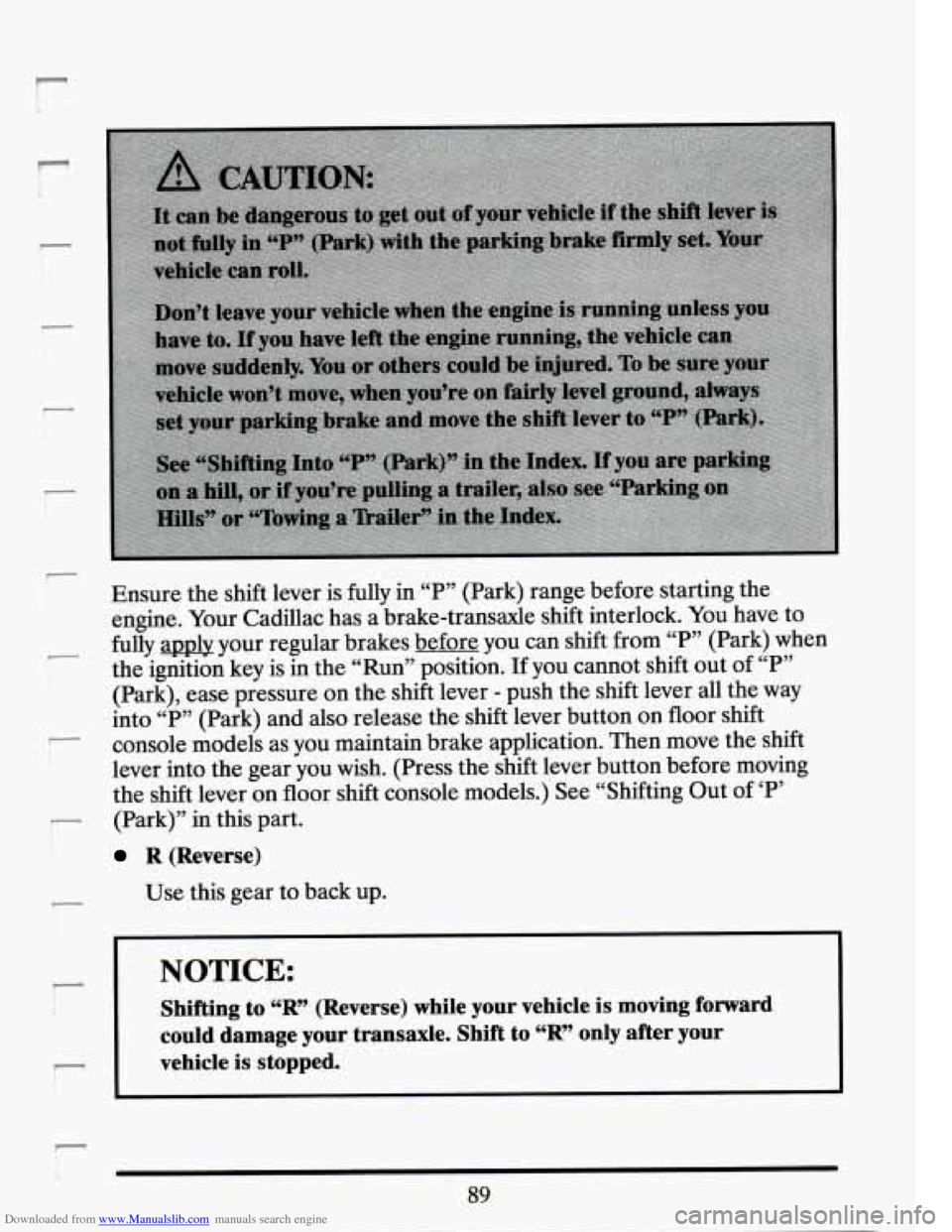
Downloaded from www.Manualslib.com manuals search engine r
-
- i
-
Ensure the shift lever is fully in “P7’ (Park) range before starting the
engine. Your Cadillac has a brake-transaxle shift interlock. You have to
fully apply your regular brakes before you can shift from ‘‘P” (Park) when
the ignition key is in the “Run” position.
If you cannot shift out of “P”
(Park), ease pressure on the shift lever
- push the shift lever all the way
into ‘‘P77 (Park) and also release the shift lever button on floor shift
console models as you maintain brake application. Then move the shift
lever into the gear you wish. (Press the shift lever button before moving
the shift lever on floor shift console models.) See “Shiftine Out of ‘P’
(Park)” in this part.
R (Reverse)
._
I
Use this gear to back up.
r
NOTICE:
Shifting to “R” (Reverse) while your vehicle is moving forward
could damage your transaxle. Shift to “R” only after your\
vehicle is stopped.
Page 104 of 399
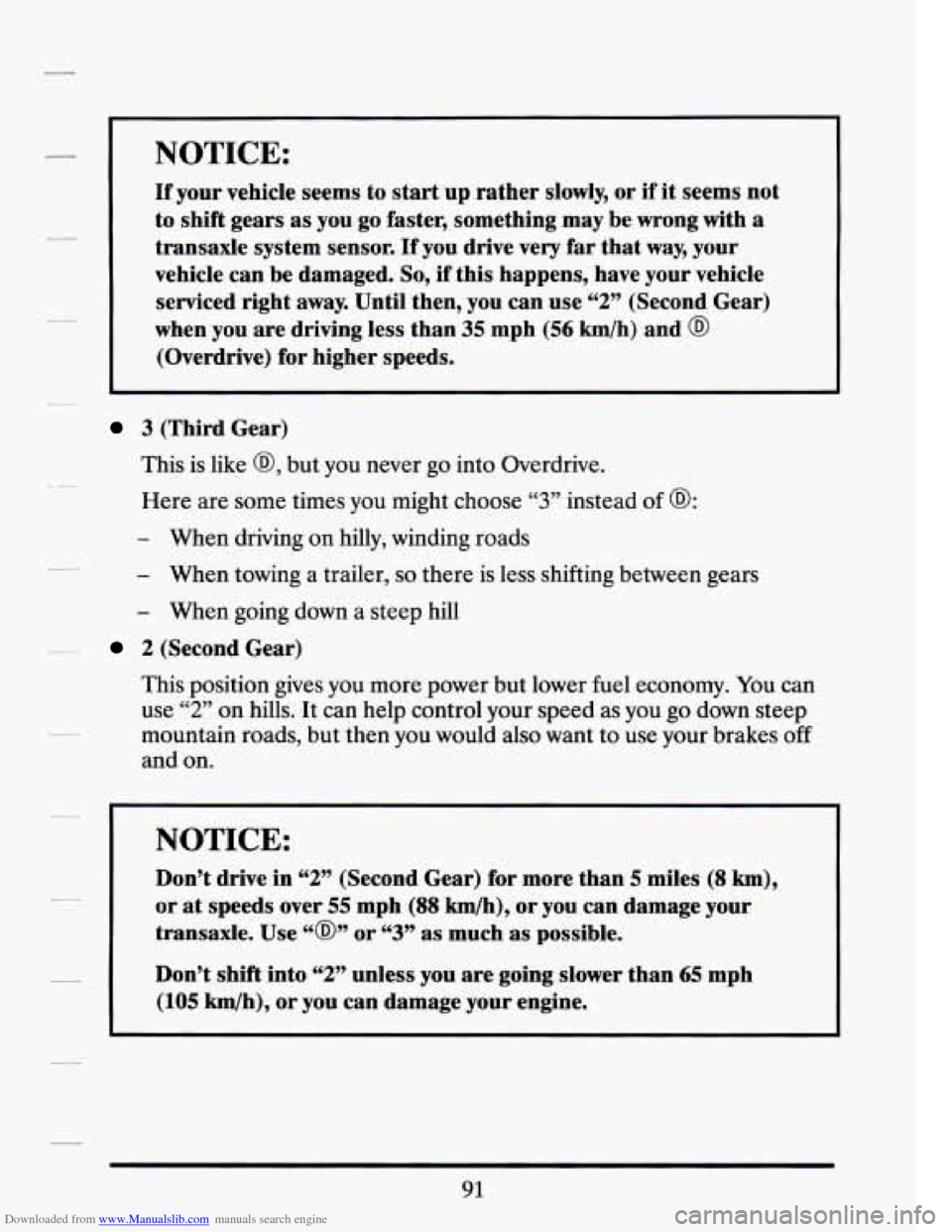
Downloaded from www.Manualslib.com manuals search engine NOTICE:
If your vehicle seems to start up rather slowly, or if it seems not
to shift gears
as you go faster, something may be wrong with a
transaxle system sensor. If you drive very far that way, your
vehicle can be damaged.
So, if this happens, have your vehicle
serviced right
away. Until then, you can use “2” (Second Gear)
when you
are driving less than 35 mph (56 km/h) and @
(Overdrive) for higher speeds.
3 (Third Gear)
This is like
@, but you never go into Overdrive.
Here are some times
you might choose “3” instead of 0:
- When driving on hilly, winding roads
- When towing a trailer, so there is less shifting between gears
- When going down a steep hill
2 (Second Gear)
This position gives
you more power but lower fuel economy. You can
use
“2” on hills. It can help control your speed as you go down steep
mountain roads, but then you would also want to use your brakes
off
and on.
NOTICE:
Don’t drive in “2” (Second Gear) for more than 5 miles (8 km),
or at speeds over 55 mph (88 km/h), or you can damage your
transaxle. Use
“@” or “3” as much as possible.
Don’t shift into
“2” unless you are going slower than 65 mph
(105 km/h), or you can damage your engine.
I
91
Page 105 of 399
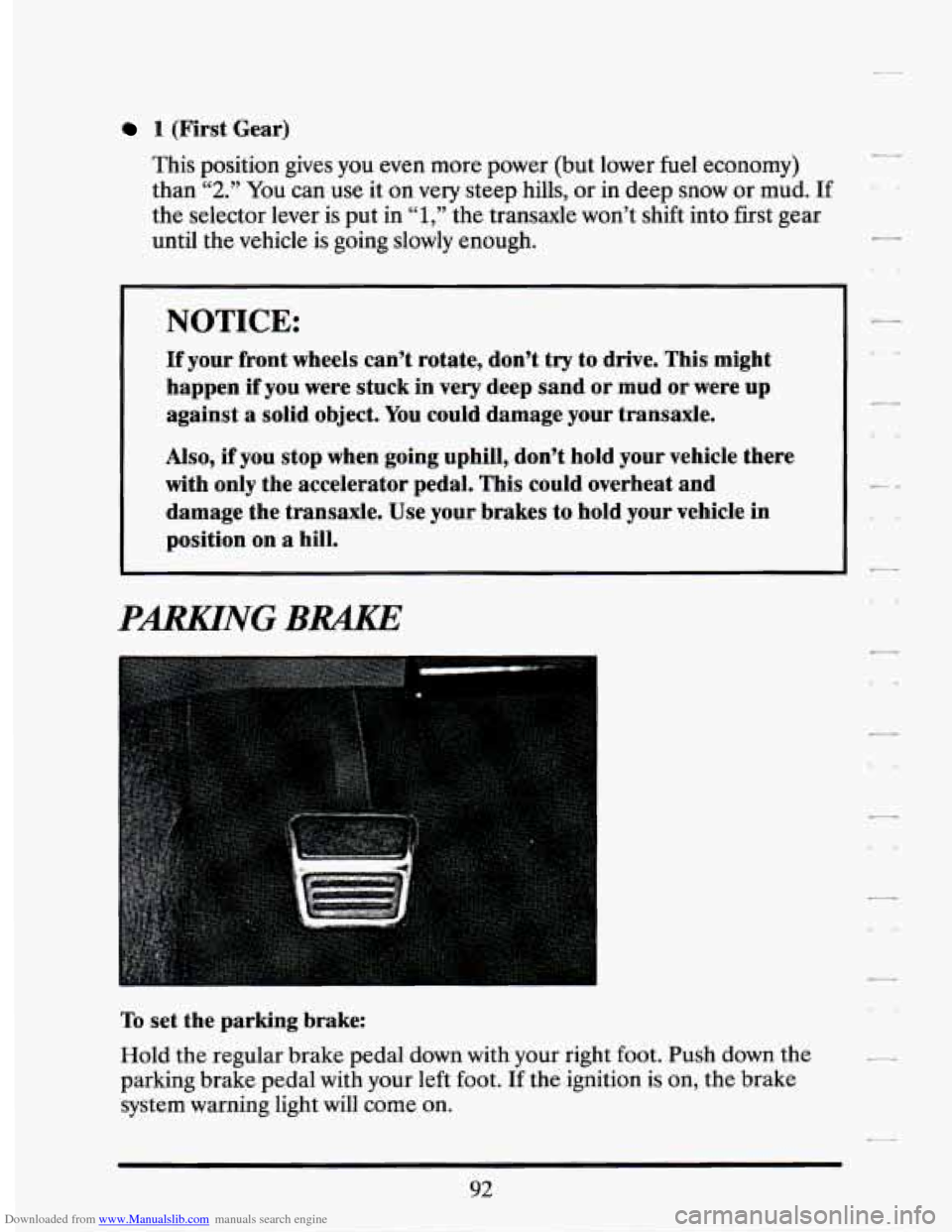
Downloaded from www.Manualslib.com manuals search engine 1 (First Gear)
This position gives you even more power (but lower fuel economy)
than
“2.” You can use it on very steep hills, or in deep snow or mud. If
the selector lever is put in “1,” the transaxle won’t shift into first gear
until the vehicle is going slowly enough.
NOTICE:
If your front wheels can’t rotate, don’t try to drive. This might
happen
if you were stuck in very deep sand or mud or were up
against
a solid object. You could damage your transaxle.
I-
l-
Also, if you stop when going uphill, don’t hold your vehicle there
with only the accelerator pedal. This could overheat and
damage the transaxle. Use your brakes to hold your vehicle in
position on
a hill.
I
I --
PARKlNG BRAKE
To set the parking brake:
Hold the regular brake pedal
down with your right foot. Push down the
parking brake pedal with your left foot.
If the ignition is on, the brake
system warning light will
come on.
92
Page 106 of 399

Downloaded from www.Manualslib.com manuals search engine When you move out
of “P” (Park) or
“N”
(Neutral), if your
engine is running,
your parking brake
should go
off. If it
doesn’t, you have a
parking brake
problem and should
have it fixed.
In the
meantime, you can
still release your
parking brake. Just pull on the manual
release lever, as
shown.
I NOTICE:
Driving with the parking brake on can cause your rear brakes to
overheat. You may have
to replace them, and you could also
damage other parts
of your vehicle.
If you are on a hill: See “Parking on Hills” in the Index. That section
shows how to
turn your front wheels.
If you are towing a trailer and are parking on any hill: See “Towing a
Trailer” in the Index. That section shows what to
do first to keep the
trailer from moving.
93
Page 122 of 399
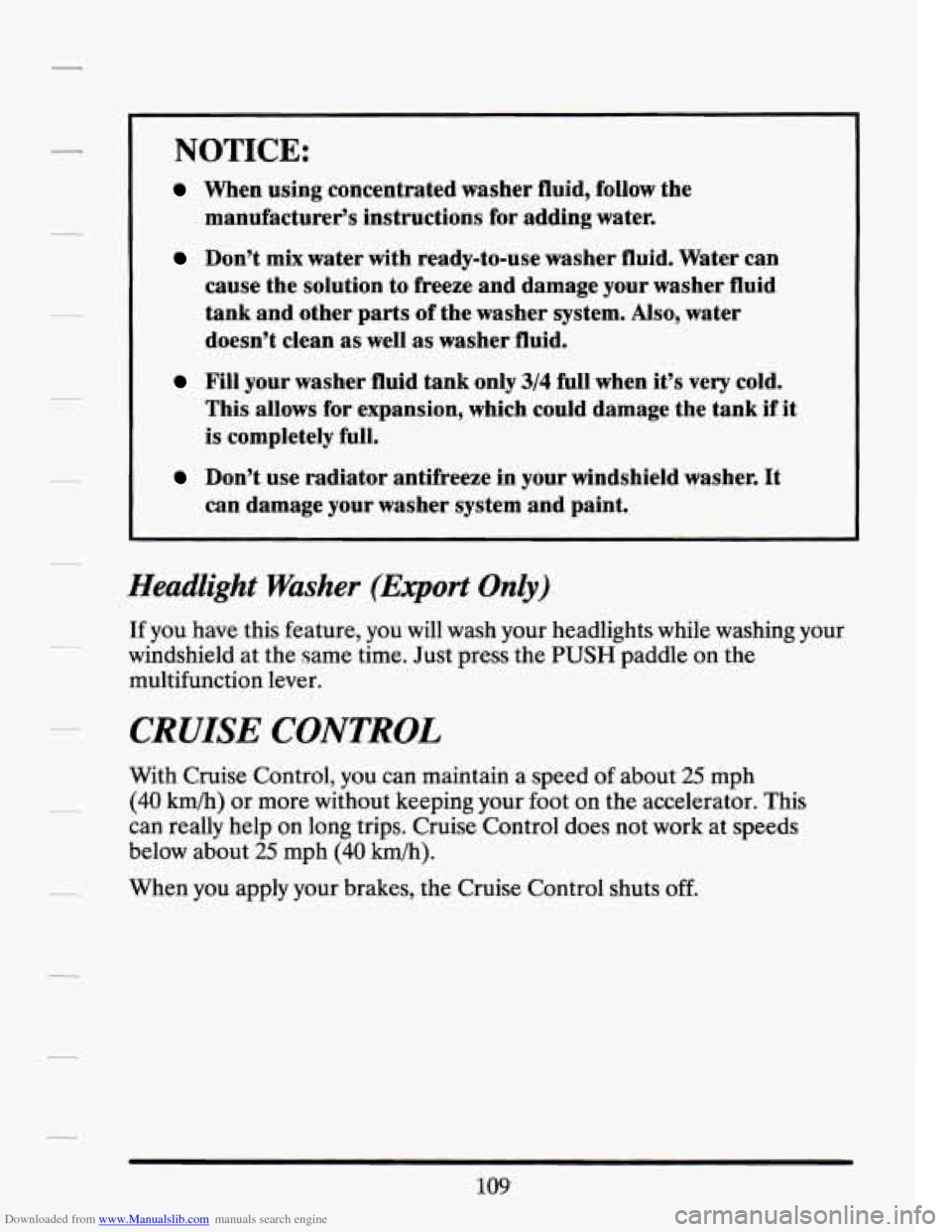
Downloaded from www.Manualslib.com manuals search engine NOTICE:
When using concentrated washer fluid, follow the
manufacturer’s instructions for adding water.
Don’t mix water with ready-to-use washer fluid. Water can
cause the solution to freeze and damage your washer fluid
tank and other parts of the washer system.
Also. water
doesn’t clean as well
as washer fluid.
Fill your washer fluid tank only 3/4 full when it’s very cold.
This allows for expansion, which could damage the tank if it
is completely full.
Don’t use radiator antifreeze in your windshield washer. It
can damage your washer system and paint.
Headlight Washer (Export Only)
If you have this feature, you will wash your headlights while washing your
windshield at the same time. Just press the
PUSH paddle on the
multifunction lever.
CRUISE CONTROL
With Cruise Control, you can maintain a speed of about 25 mph
(40 km/h) or more without keeping your foot on the accelerator. This
can really help on long trips. Cruise Control does not work at speeds
below about 25 mph
(40 km/h).
When you apply your brakes, the Cruise Control shuts off.
109’
Page 148 of 399
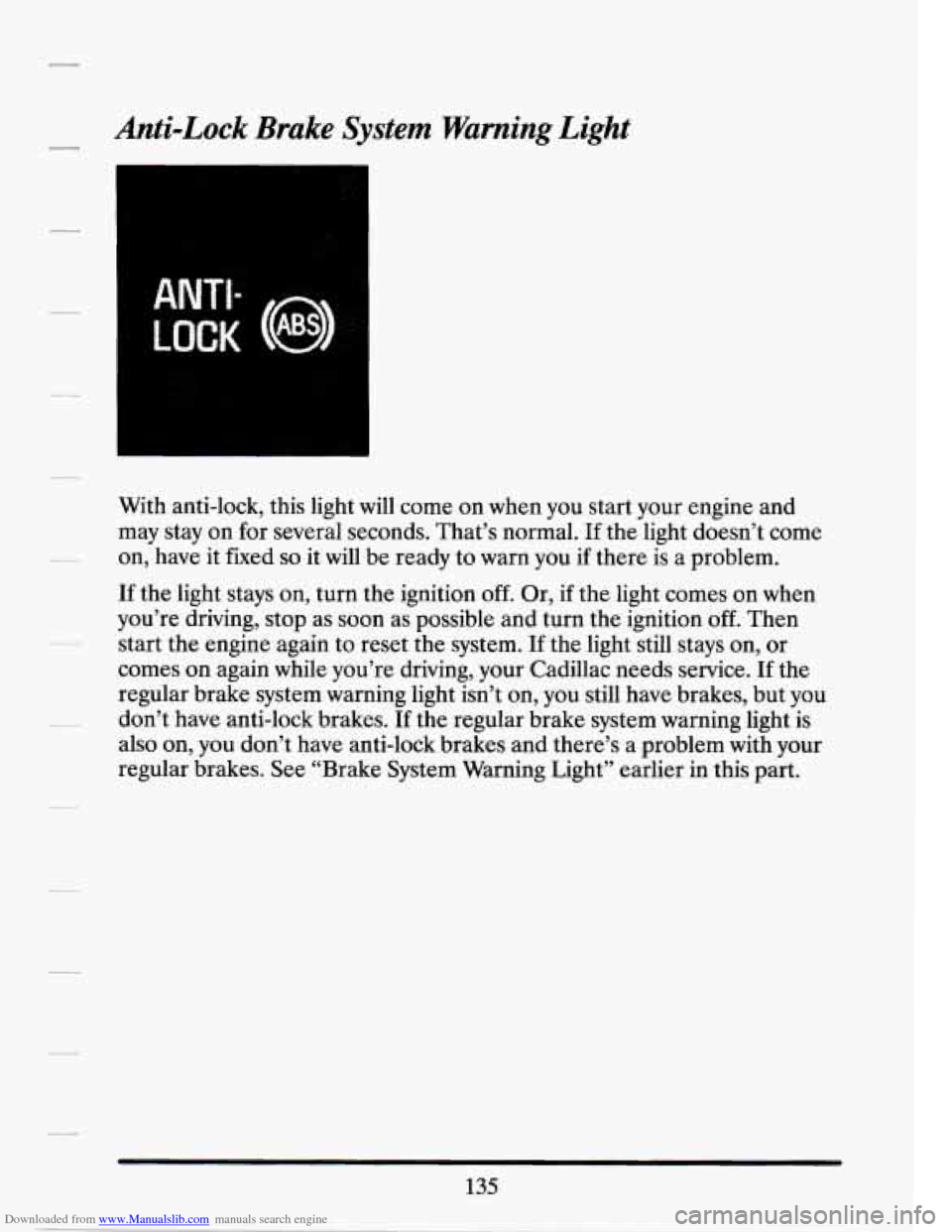
Downloaded from www.Manualslib.com manuals search engine Anti-Lock Brake System Warning Light
II
With anti-lock, this light will come on when you start your engine and
may stay on for several seconds. That’s normal.
If the light doesn’t come
on, have it fixed
so it will be ready to warn you if there is a problem.
If the light stays on, turn the ignition off. Or, if the light comes on when
you’re driving, stop as soon
as possible and turn the ignition off. Then
start the engine again to reset the system. If the light still stays on, or
comes on again while you’re driving, your Cadillac needs service. If the
regular brake system warning light isn’t on, you still have brakes, but you
don’t have anti-lock brakes. If the regular brake system warning light is
also on, you don’t have anti-lock brakes and there’s a problem with your
regular brakes. See “Brake System Warning Light” earlier in this part.
135
Page 190 of 399

Downloaded from www.Manualslib.com manuals search engine person with a higher BAC might not be able to react quickly enough to
avoid the collision.
There’s something else about drinking and driving that many people
don’t know. Medical research shows that alcohol in a person’s system can
make crash injuries worse. That’s especially true for brain, spinal cord
and heart injuries. That means that if anyone who has been drinking
--
driver or passenger -- is in a crash, the chance of being killed or
permanently disabled is higher than
if that person had not been drinking.
And we’ve already seen that the chance of a crash itself
is higher for
drinking drivers.
CONTROL OF A VEHICLE
You have three systems that make your vehicle go where you want it to
go. They are the brakes, the steering and the accelerator. All three
systems have to
do their work at the places where the tires meet the road.
Page 191 of 399

Downloaded from www.Manualslib.com manuals search engine 3
Sometimes, as when you’re driving on snow or ice, it’s easy to ask more of
those control systems than the tires and road can provide. That means
you can lose control of your vehicle.
BRAKIN%
Braking action involves perception time and reaction time.
First, you have to decide to push on the brake pedal. That’s perception
time. Then you have to bring up your foot and do it. That’s reaction time.
Average reaction time is about
3/4 of a second. But that’s only an
average. It might be less with one driver and as long as
two or three
seconds or more with another. Age, physical condition, alertness,
coordination, and eyesight all play a part.
So do alcohol, drugs and
frustration. But even
in 3/4 of a second, a vehicle moving at 60 mph
(100 km/h) travels 66 feet (20 m). That could be a lot of distance in an
emergency,
so keeping enough space between your vehicle and others is
important.
And, of course, actual stopping distances vary greatly with the surface of
the road (whether it’s pavement or gravel); the condition of the road
(wet, dry, icy); tire tread; and the condition
of your brakes.
Avoid needless heavy braking. Some people drive in spurts
-- heavy
acceleration followed by heavy braking
-- rather than keeping pace with
traffic. This is
a mistake. Your brakes may not have time to cool between
hard stops. Your brakes will wear out much faster
if you do a lot of heavy
braking.
If you keep pace with the traffic and allow realistic following
178
7
Page 192 of 399

Downloaded from www.Manualslib.com manuals search engine distances, you will eliminate a lot of unnecessary braking. That means
better braking and longer brake life.
If your engine ever stops while you’re driving, brake normally but don’t
pump your brakes.
If you do, the pedal may get harder to push down. If
your engine stops, you will still have some power brake assist. But you will
use it when you brake. Once the power assist is used up, it may take
longer to stop and the brake pedal will be harder to push.
Anti-Lock Brakes (ABS)
Your Cadillac has an advanced electronic braking system that will help
prevent skidding.
This light on the
instrument panel will
go
on when you start
your vehicle.
ANTI-
LOCK (@!
When you start your vehicle and begin to drive away, you may hear a
momentary motor or clicking noise. And you may even notice that your
brake pedal moves a little while this is going on. This is the
ABS system
testing itself.
If there’s a problem with the anti-lock brake system, the
anti-lock brake system warning light will stay on.
See “Anti-lock Brake System Warning Light’’ in the Index.
179